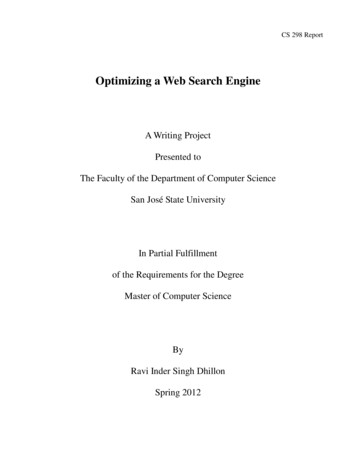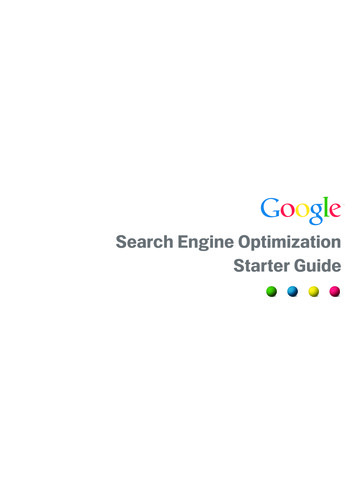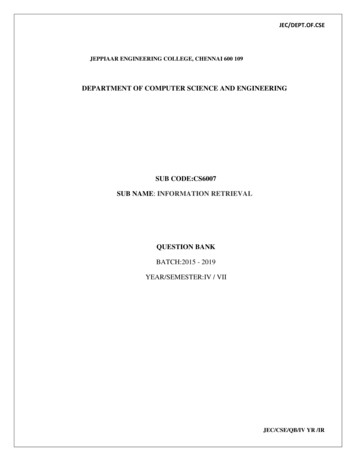
Transcription
CS 298 ReportOptimizing a Web Search EngineA Writing ProjectPresented toThe Faculty of the Department of Computer ScienceSan José State UniversityIn Partial Fulfillmentof the Requirements for the DegreeMaster of Computer ScienceByRavi Inder Singh DhillonSpring 2012
CS298 Report 2012Ravi Inder Singh DhillonALL RIGHTS RESERVED
CS298 ReportSAN JOSÉ STATE UNIVERSITYThe Undersigned Thesis Committee Approves the Thesis TitledOptimizing a Web Search EngineByRavi Inder Singh DhillonAPPROVED FOR THE DEPARTMENT OF COMPUTER SCIENCEDr. Chris Pollett, Department of Computer Science 5/11/2012Dr. Jon Pearce, Department of Computer Science5/11/2012Dr. Robert Chun, Department of Computer Science 5/11/2012-3
CS298 ReportABSTRACTSearch Engine queries often have duplicate words in the search string. Forexample user searching for "pizza pizza" a popular brand name for Canadian pizzeriachain. An efficient search engine must return the most relevant results for suchqueries. Search queries also have pair of words which always occur together in thesame sequence, for example “honda accord”, “hopton wafers”, “hp newwave” etc.We will hereafter refer to such pair of words as bigrams. A bigram can be treated as asingle word to increase the speed and relevance of results returned by a search enginethat is based on inverted index. Terms in a user query have a different degree ofimportance based on whether they occur inside title, description or anchor text of thedocument. Therefore an optimal weighting scheme for these components is requiredfor search engines to prioritize relevant documents near the top for user searches.The goal of my project is to improve Yioop, an open source searchengine created by Dr Chris Pollett, to support search for duplicate terms and bigramsin a search query. I will also optimize the Yioop search engine by improving itsdocument grouping and BM25F weighting scheme. This would allow Yioop to returnmore relevant results quickly and efficiently for users of the search engine.-4
CS298 ReportACKNOWLEDGEMENTSI would like to thank my advisor Dr. Chris Pollett for providing his valuabletime, constant guidance and support throughout this project. I appreciate and thankmy committee members Dr. Jon Pearce and Dr. Robert Chun for their time andsuggestions. I would also like to thank my family and friends for their moral supportduring the project. A special thanks to my fellow student Sharanpal Sandhu for peerreviewing the project report.-5
CS298 ReportTable of Contents1. Introduction.102. Technologies Used.142.1. PHP.142.2. TREC Software.152.3. Cygwin.153. Yioop! Search Engine.163.1. System Architecture.163.2. Inverted Index.194. Supporting duplicate query terms in Yioop.214.1. Existing Implementation.214.2. Modified Implementation.225. Writing an improved Proximity ranking algorithm for Yioop!.255.1. Problem Statements.255.1.1. Distinct K-word proximity search for ranking documents.255.1.2. Non Distinct K-word proximity search for ranking documents.265.2. Algorithms.265.2.1 Plane-sweep algorithm.265.2.2. Modified Plane-sweep algorithm.285.3. Proximity Ranking.305.4. Implementation.316. TREC comparison.346.1. Installing TREC software.346.2. Baseline results.356.3. Comparison results for Yioop before code changes.376.4. Comparison results for Yioop after code changes.387. Implementing bigrams in Yioop!.407.1. Finding bigram source.41-6
CS298 Report7.1.1. Downloading English Wikipedia.417.1.2. Uncompress Wikipedia dump.427.2. Parse XML to generate bigrams.437.3. Create bigram filter file.457.4. Extract bigrams in Phrases.477.5. Bigram builder tool.497.6. Speed of retrieval.497.6.1. Results for bigram word pairs.507.6.2. Results for non-bigram word pairs.517.7. TREC comparison.537.7.1. Comparison results for Yioop before implementing bigrams.537.7.2. Comparison results for Yioop after implementing bigrams.538. Optimal BM25F weighing in Yioop!.559. Optimal document grouping in Yioop!.5710. Conclusion.59References . . . 61-7
CS298 ReportTable of FiguresFigure 1. Yioop directory Structure.16Figure 2. Mini inverted index in Yioop.19Figure 3. Words and corresponding word iterators for distinct terms.22Figure 4. Words and corresponding word iterators for non-distinct terms.23Figure 5. Dictionary with key as word number and value as iterator number.23Figure 6. Covers vs Non Covers for distinct keywords.27Figure 7. Covers vs Non Covers for non distinct keywords.28Figure 8. Formula used to compute proximity score.31Figure 9. Function used to find covers in document.32Figure 10. Function used to rank covers and find proximity score.33Figure 11. Checking the installation of trec eval in Cygwin.35Figure 12. Top ten baseline results for query “sjsu math”.36Figure 13. Trec comparison results for Yioop before code changes.38Figure 14. Trec comparison results for Yioop after code changes.39Figure 15. Code for function to uncompress the bz2 compressed xml.43Figure 16. Code for function to create bigrams text file from input xml.44Figure 17. Code for function used to create the bigram filter.46Figure 18. Code for function used to extract bigrams in phrases.48Figure 19. Sample run of the bigram builder tool.49Figure 20. Yioop statistics for search query “Cox Enterprises”.50Figure 21. Yioop statistics for search query “Hewlett Packard”.50Figure 22. Yioop statistics for search query “Baker Donelson”.51Figure 23. Yioop statistics for search query “Plante Moran”.51Figure 24. Graphical comparison for speed of retrieval in Yioop.52Figure 25. Trec comparison results for Yioop before implemeting bigrams.53Figure 26. Trec comparison results for Yioop after implementing bigrams.54Figure 27. BM25F weighting options in Yioop.55Figure 28. Yioop trec results obtained by varying BM25F weighting.56-8
CS298 ReportFigure 29. Document grouping options in Yioop!. . .57Figure 30. Yioop trec results obtained by varying cutoff scanning posting list.58-9
CS298 Report1. IntroductionSearch engine queries frequently have duplicate terms in the search string.Several companies use duplicate words to name their brand or website. For examplepizza pizza is a popular brand name of a very large chain of pizzerias in Canada.Another example is the official website “www.thethe.com” of the English musical andmultimedia group “The The”. Similarly there are many examples where duplicateterms have a special meaning when a user is searching for information through asearch engine. Currently Yioop search engine does not distinguish between duplicateterms in a search query. It removes all the duplicate terms from the user search querybefore processing it. This means that a user query “pizza pizza” will be treated as“pizza” before processing. Therefore the results returned for such queries by thesearch engine may not be as expected by the user. Yioop scores documents forqueries based on their relevance scores and proximity scores. The relevance score forquery is based on OPIC ranking and BM25F weighting of the terms. While proximityscoring, which is completely offline, is based on how close the terms are in a givendocument. A good proximity score means that it is more likely that the keywordshave a combined meaning in the document. Therefore an efficient proximity rankingalgorithm is highly desirable especially for queries with duplicate terms. CurrentlyYioop has a proximity ranking algorithm which is very ad hoc and does not supportduplicate terms in the query.In this project I have modified the Yioop code so that it does not removeduplicate terms in the query and written a new Proximity ranking algorithm that gives- 10
CS298 Reportthe best measure of proximity even with duplicate terms in query. The proximityranking algorithm I have written is based on a modified implementation of the Planesweep algorithm, which is a k-word near proximity search algorithm for k distinctterms occurring in document. The modified implementation allows duplicate terms inthe algorithm and is a k-word near proximity search algorithm for k non-distinctterms.There are several techniques used by popular search engines to increase thespeed and accuracy of results retrieved for a user query. One of such techniques iscombining pair of words which always occur together in the same sequence. We referto such pairs as bigrams. For example “honda accord”, “hopton wafers”, “hpnewwave”, etc are bigrams. However if these words are not in the same sequence orseparated by other words between them they act as independent words. Bigrams canbe treated as single words while creating the inverted index for documents during theindexing phase. Similarly when the user query has these pair of words we treat themas single words to fetch documents relevant to the search. This technique speeds upthe retrieval of documents and getting user desired results at the top. I have madeincrements to the Yioop code so that it supports bigrams in the search query. Thisinvolved identifying a list of all pair of words which could qualify as bigrams. Duringthe indexing phase the search engine checks the presence of all the bigrams in a givendocument by comparing each pair of consecutive words against the list of availablebigrams. Then based on this comparison it creates an inverted index for both thebigrams as well as individual words in the posting list. During the query phase we- 11
CS298 Reportcheck all consecutive pair of words in query string against the list of availablebigrams to identify qualifying bigrams. Then these bigrams are used to fetchdocuments from the inverted index. Since we have already filtered documents withboth the words (bigram pair) in them, we speed up the process of finding documentswhich have all the words in the query string present in them.The testing for the changes made to the Yioop search engine was achievedby comparing the results obtained from Yioop against the baseline TREC results.TREC baseline is a predefined set of ideal results that a search engine must return fora given set of user search queries. We search for queries used to create baseline usingoriginal Yioop version 0.8 at the beginning of the project and record the results. Wecompare these results with the baseline results using the TREC software which givesus the relevant results returned by original Yioop search engine. During the course ofthis project new results were retrieved from Yioop after making any changes to itssource code and recorded. The comparison between recorded results was donethrough TREC software to get a numerical value of improvement in relevance ofretrieval.Title, body and anchor text of a document hold a different degree ofimportance for user queries. Yioop employs the BM25F ranking function to assigndifferent integer weights to these parts. In this project we find an optimal distributionof weights for these components by varying them and comparing the results retrievedusing TREC.In Yioop posting list is a set of all documents in archive which contain a- 12
CS298 Reportword in the index. For large crawls this posting list is very large and needs to betrimmed to get the most relevant documents for a given query. Hence Yioop choosesan arbitrary cutoff point for scanning this posting list to group documents. In thisproject we find an optimal cutoff point for scanning posting list by comparing theresults retrieved using TREC.- 13
CS298 Report2. Technologies UsedThe project was based on improving the Yioop! search engine. Yioop! searchengine is a GPLv3, open source, PHP search engine. The main technology usedduring the project was PHP. Apache server in the XAMPP bundle was used as theweb server. XAMPP is an easy to install Apache distribution containing MySQL,PHP and Perl. The other technologies used were TREC software and Cygwin. TRECsoftware was used to compare the results obtained from search engine before andafter making the changes to it. Cygwin was used as a host environment to run theTREC software. Editor used to modify the source files was Textpad.2.1. PHPPHP is a widely-used general-purpose server-side scripting language that isespecially suited for Web development and can be embedded into HTML to producedynamic web pages. PHP code is embedded into the HTML source document andinterpreted by a web server with a PHP processor module, which generates the webpage document. Yioop! search engine has been developed using PHP server scripting,HTML and Javascript. Most of my work for this project was writing code in PHP.PHP also includes a command line interface to run scripts written in PHP. Yioop!search engine uses the command line interface to run the fetcher and queue serverscripts used to crawl the internet along with its web interface.- 14
CS298 Report2.2. TREC SoftwareThe Text REtrieval Conference (TREC) is an on-going series of workshopsfocusing on a list of different information retrieval (IR) research areas, or tracks. Itspurpose is to support research within the information retrieval community byproviding the infrastructure necessary for large-scale evaluation of text retrievalmethodologies. Trec Eval Software is a standard tool used by the TREC communityfor evaluating ad hoc retrieval runs, given the results file and a standard set of judgedresults. TREC Eval software was used in the project to compare results before andafter making changes to Yioop search engine.2.3. CygwinCygwin is a Unix-like environment and command-line interface for MicrosoftWindows. Cygwin provides native integration of Windows-based applications, data,and other system resources with applications, software tools, and data of the Unixlike environment. Cygwin environment was used to compile the source code ofTREC Eval software using gcc libraries to generate the executable. The executablewas then used to run the software in Cygwin to compare results generated by searchengine with a standard set of results.- 15
CS298 Report3. Yioop! Search EngineYioop! is an open source, GPLv3, PHP search engine developed by ChrisPollett. It was chosen for this project because it is open source and continuouslyevolving with various developers contributing to its code. Yioop was at its releaseversion 0.8 at the beginning of this project. Yioop lets users to create their owncustom crawls of the internet.3.1. System ArchitectureYioop search engine follows a MVC (Model-View-Controller) pattern in itsarchitecture. It has been written in PHP, requires a web server with PHP 5.3 or betterand Curl libraries for downloading web documents. The various directories and filesin Yioop are shown below.Figure 1: Yioop directory Structure- 16
CS298 ReportFollowing are the major files and folders in Yioop which were used in the project.word iterator.phpThis iterator file is present in the index bundle iterator folder and is used to iteratethrough the documents associated with a word in an Index archive bundle. This filecontains methods to handle and retrieve summaries of these documents in an easymanner. In section 4.2 we create a dictionary for words and correspondingword iterators to support duplicate terms in Yioop.intersect iterator.phpThis iterator file is present in the index bundle iterator folder and is used to iterateover the documents which occur in all of a set of iterator results. In other words itgenerates an intersection of documents which will have all the words correspondingto individual word iterators. This file contains the Proximity ranking function whichwill be modified section 5 to efficiently compute a proximity score of each qualifyingdocument based on relative position of words inside them.group iterator.phpThis iterator file is present in the index bundle iterator folder and is is used to grouptogether documents or document parts which share the same url. This file has aparameter MIN FIND RESULTS PER BLOCK which specifies how far we go inthe posting list to retrieve the relevant documents. We will run experiments todetermine an optimal value for this parameter so that Yioop produces efficient searchresults in shortest time.- 17
CS298 Reportphrase parser.phpThis file is present in the lib folder and provides library of functions used tomanipulate words and phrases. It contains functions to extract phases from an inputstring which can be a page visited by crawler or user query string. This file ismodified to support duplicate query terms in Yioop and implementing bigrams.phrase model.phpThis file is present in the models folder and is used to handle results for a givenphrase search. Using the files from index bundle iterator it generates the requirediterators to retrieve documents relevant to the query. This file was modified to includedictionary for supporting duplicate terms in Yioop discussed in section 4.2.bloom filter file.phpThis file is present in the lib folder and contains code used to manage a bloom filterin-memory and in file. A Bloom filter is used to store a set of objects. It can supportinserts into the set and it can also be used to check membership in the set. In thisproject we have implemented the bigram functionality in Yioop discussed in section7. This involved creating a bloom filter file for a large set of word pairs which qualifyas bigrams. This bigram filter file is then used to check the presence of bigrams indocuments visited by crawler and user search queries. The bigrams present indocument are then indexed as a single words to be used in search results.- 18
CS298 Report3.2. Inverted IndexAn inverted index also referred to as postings file or inverted file is an indexstructure which stores a mapping from words to their locations in a document or a setof documents allowing full text search. In Yioop “fetcher.php” creates a mini invertedindex by storing the location of each word in a web document and sends in back to“queue server.php”. “queue server.php” adds it to the global inverted index.Figure 2: mini inverted index in YioopWhen a user submits a query to the Yioop search engine there are many qualifyingdocuments with all the terms in the query present in them. However each documentcontains all the keywords in totally different context. Therefore Yioop has to find therelevant documents and prioritize them. Yioop uses Page rank and Hub & Authority,both based on links between documents, to compute relevance of documents. Besidesthis Yioop also computes the proximity score of documents based on the textualinformation i.e. how close the keywords appear together in a document (Proximity).If the proximity is good, it is more likely that query terms have a combined meaning- 19
CS298 Reportin the document. The location information of words in a document (mini invertedindex) is used by Yioop to generate the proximity score for each qualifyingdocument. The resultant documents given back to the user are ordered by total scoreof each document. We will use this location information of the mini inverted index towrite an efficient Proximity ranking algorithm in section 5. This algorithm is amodified implementation of Plane sweep algorithm and supports duplicate terms inthe query string i.e. even though duplicate words have the same position list they aretreated distinct by the algorithm.- 20
CS298 Report4. Supporting duplicate query terms in Yioop!The following section describes the changes that were made to supportduplicate query terms in Yioop user search query.4.1. Existing Implementation (For Yioop version 0.8 till Oct 2011)Yioop currently does not distinguish between duplicate terms in a user searchquery. It removes all the duplicate terms while processing the request. To supportduplicate terms in Yioop the flow of code was studied to make modifications thatwould help distinguish between identical query terms. “phrase model.php” file inYioop interprets the user query and removes all the duplicate terms from it. For eachdistinct word in the search query it creates a word iterator which is used to fetchdocuments which contain that word. It then takes this collection of word iterators andmakes a call to the file “intersect iterator.php”. This file takes an intersection of theseword iterators to find the documents which contain all the distinct words in the searchquery. Whenever it finds a document that contains all the distinct words in the searchquery, it computes a proximity score of terms by calling the functioncomputeProximity. This proximity score is used while ranking the documents forrelevance. One of the arguments passed to the function computeProximity is theposition list of each of the distinct terms in the given document. The position list of aterm in the qualified document is obtained through the inverted index information inthe word iterator corresponding to the term.- 21
CS298 Report“does sweet tomatoes serve sweet tomatoes”“phrase model.php” removes duplicates and converts the above user query into“does sweet tomatoes serve”Following table shows the word iterators created after removing duplicates.doessweettomatoesserveW1W2W3W4Figure 3: Words and corresponding word iterators for distinct termsIt then sends the list (W1, W2, W3, W4) to “intersect iterator.php” and loses all theinformation about duplicate terms. If (L1, L2, L3, L4) is a list of position lists of allthe four distinct terms in a given document then computeProximity is called with theargument list (L1, L2, L3, L4). Thus there is no information available about duplicateterms while computing proximity.4.2. Modified ImplementationIn the modified implementation code changes were made in“phrase model.php” so that duplicate terms are not removed from the array of queryterms. However the word iterators have to be created only for the distinct terms sinceduplicate terms would also have the same word iterator. Therefore we generate anarray of distinct terms and create word iterators for each of these terms. Additionallywe generate a dictionary which stores the query term number and the correspondingword iterator number.- 22
CS298 Report“does sweet tomatoes serve sweet tomatoes”For the query above we will have the word iterators and the dictionary as W3W4W2W3Figure 4: Words and corresponding word iterators for non-distinct terms012345123423Figure 5: Dictionary with key as word number and value as iterator numberNote that the order of terms in the user query is maintained in the Dictionary.Therefore we do not lose information about the duplicate terms. We now pass the listof word iterators (W1, W2, W3, W4) along with the dictionary of mapping to the“intersect iterator.php” file. In this file we again generate the documents containingall the terms in the user query by taking an intersection of the word iterators as donebefore. However, when we find a qualified document containing all the terms in userquery we generate the position list of all the terms including the duplicate termsbefore making a call to the computeProximity function. Assume that for a givendocument (L1, L2, L3, L4) is a list of position lists obtained from the word iterators(W1, W2, W3, W4) of the distinct terms in the query shown above. Then using thedictionary of mapping between query terms and corresponding word iterators we call- 23
CS298 Reportthe computeProximity function with the argument list (L1, L2, L3, L4, L2, L3). Inthis call we retain the order of terms in the user query and also include the locationinformation of the duplicate terms. Even though the location information of duplicateterms is redundant, the new modified computeProximity function will use thisinformation to calculate the proximity of query terms efficiently. Since we arepreserving the order of query terms and including the redundant terms we will get amore optimal relevance of query terms to the given document.- 24
CS298 Report5. Writing an improved Proximity ranking algorithm for Yioop!The current proximity ranking algorithm in Yioop is very ad hoc and does notsupport duplicate terms. Hence we have implemented a new proximity rankingalgorithm which is an extension of plane sweep algorithm and supports duplicateterms. Plane sweep algorithm is a distinct k-word proximity search algorithm. Wewill discuss both the distinct k-word proximity algorithm and the modified nondistinct k-word proximity algorithm.5.1. Problem Statements5.1.1. Distinct K-word proximity search for ranking documents T T[1.N ] : a text collection of length N P1,.Pk : given distinct keywords pij : the position of the jth occurrence of a keyword Pi in the text T Given a text collection T T[1.N ] of length N and k keywords P1,.Pk, wedefine a cover for this collection to be an interval [l, r] in the collection thatcontains all the k keywords, such that no smaller interval [l', r'] contained in[l, r] has a match to all the keywords in the collection. The order of keywordsin the interval is arbitrary. The goal is to find all the covers in the collection. Covers are allowed tooverlap.- 25
CS298 Report5.1.2. Non Distinct K-word proximity search for raking documents T T[1.N ] : a text collection of length N P1,.Pk : given non distinct keywords pij : the position of the jth occurrence of a keyword Pi in the text T Given a text collection T T[1.N ] of length N and k non distinct keywordsP1,.Pk, we define a cover for this collection to be an interval [l, r] in thecollection that contains all the k keywords, such that no smaller interval [l', r']contained in [l, r] has a match to all the keywords in the collection. The orderof keywords in the interval is arbitrary. The goal is to find all the covers in the collection. Covers are allowed tooverlap.5.2. Algorithms5.2.1. Plane-sweep algorithmThe plane-sweep algorithm is a distinct k-word proximity search algorithm
The testing for the changes made to the Yioop search engine was achieved by comparing the results obtained from Yioop against the baseline TREC results. TREC baseline is a predefined set of ideal results that a search engine must return for a given set of user search queries. We search for queries used to create baseline using










